Abstract
The autosomal recessive disorder, ataxia telangiectasia (AT) is characterised by cellular sensitivity to ionizing radiation. The molecular basis of this radiosensitivity is the subject of controversy. We report here that cultured fibroblasts from AT patients are also sensitive to the lethal effects of bleomycin. As with ionizing radiation, no defect has been observed in the overall rejoining of single or double-strand breaks produced by bleomycin. Since, however, only apyrimidinic (and to a lesser extent apurinic) sites and strand breaks are known to be produced by bleomycin, we tentatively suggest that AT cells are unable to rejoin a very small fraction of the total strand breaks. We attribute our inability to detect such unrejoined strand breaks to the relative insensitivity of the sucrose gradient procedures normally used to detect strand breaks.
Full text
PDF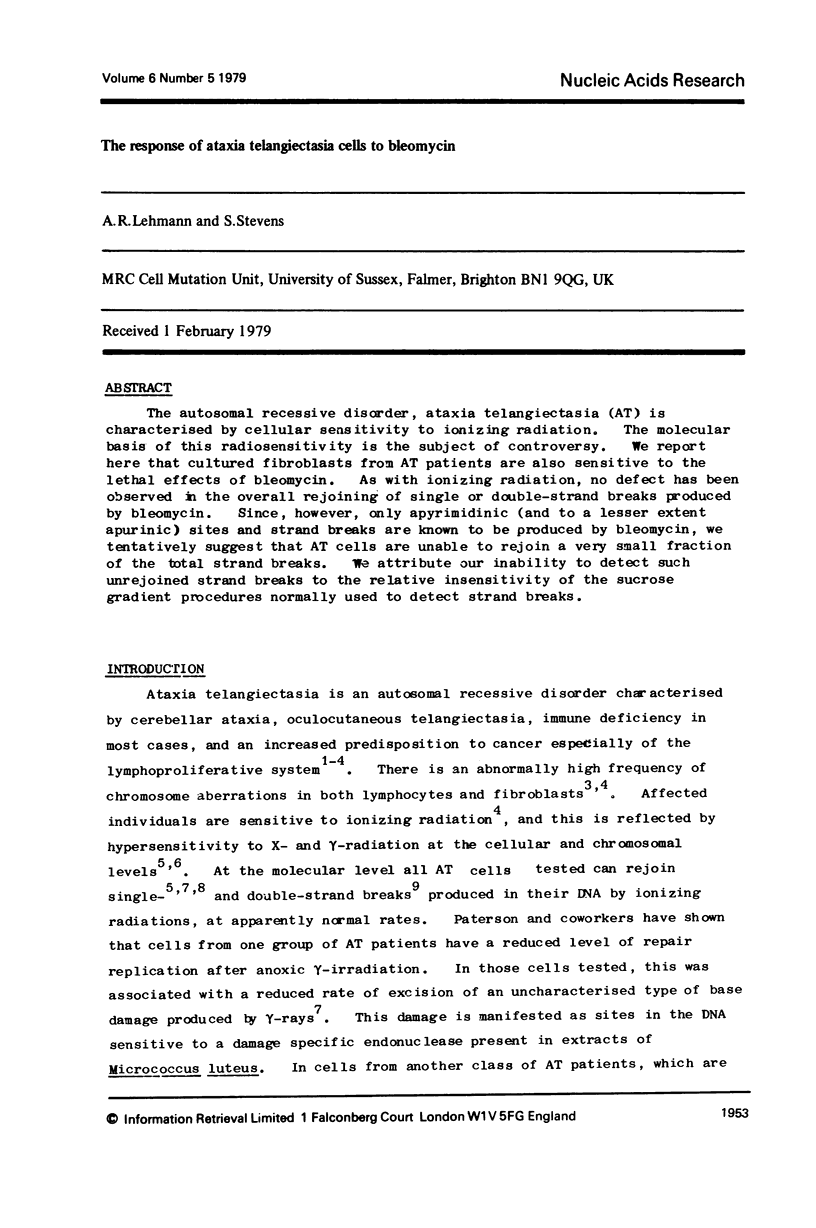
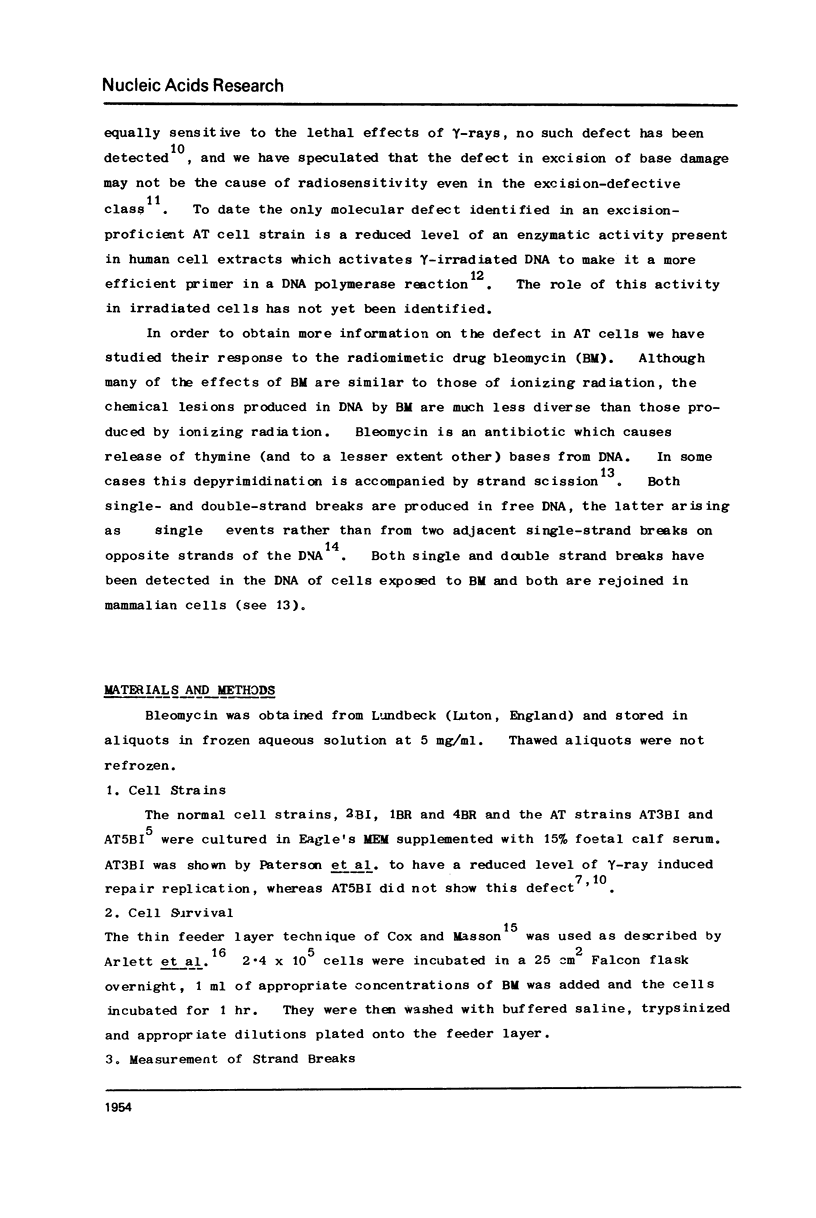
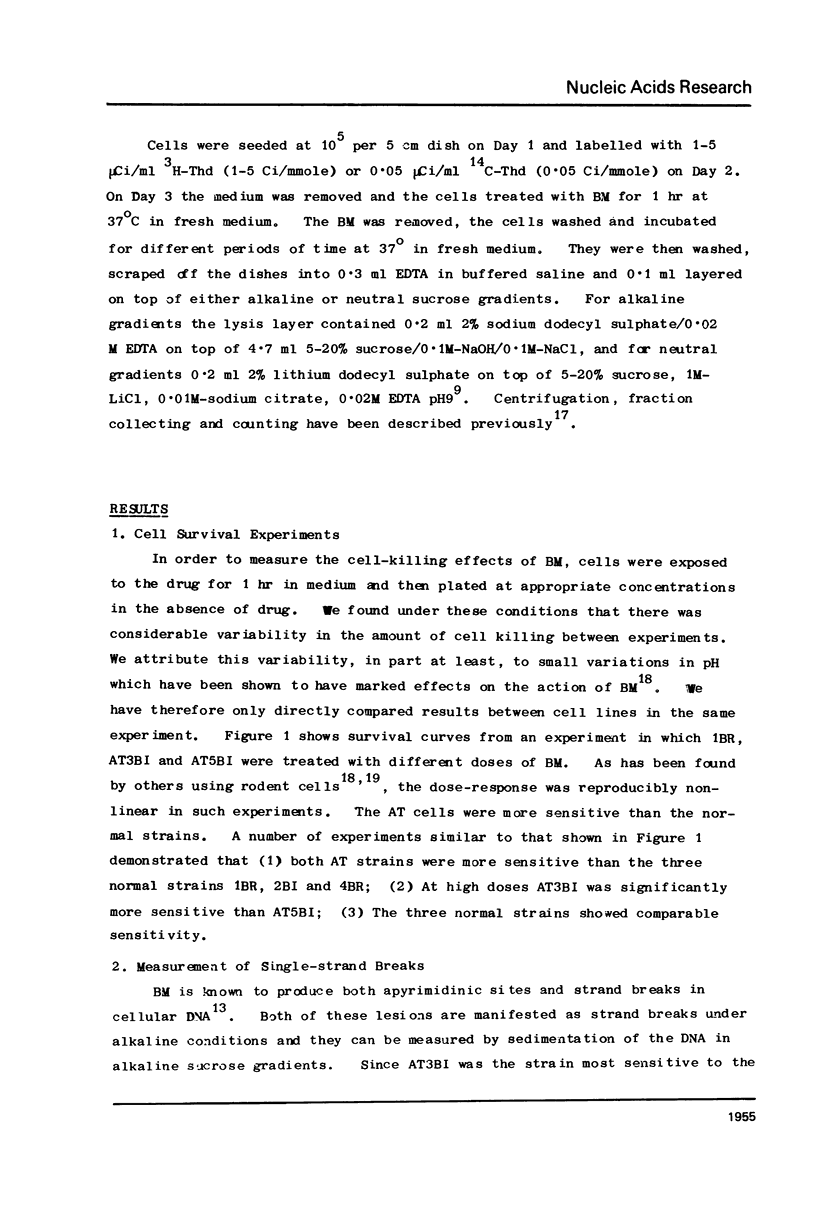
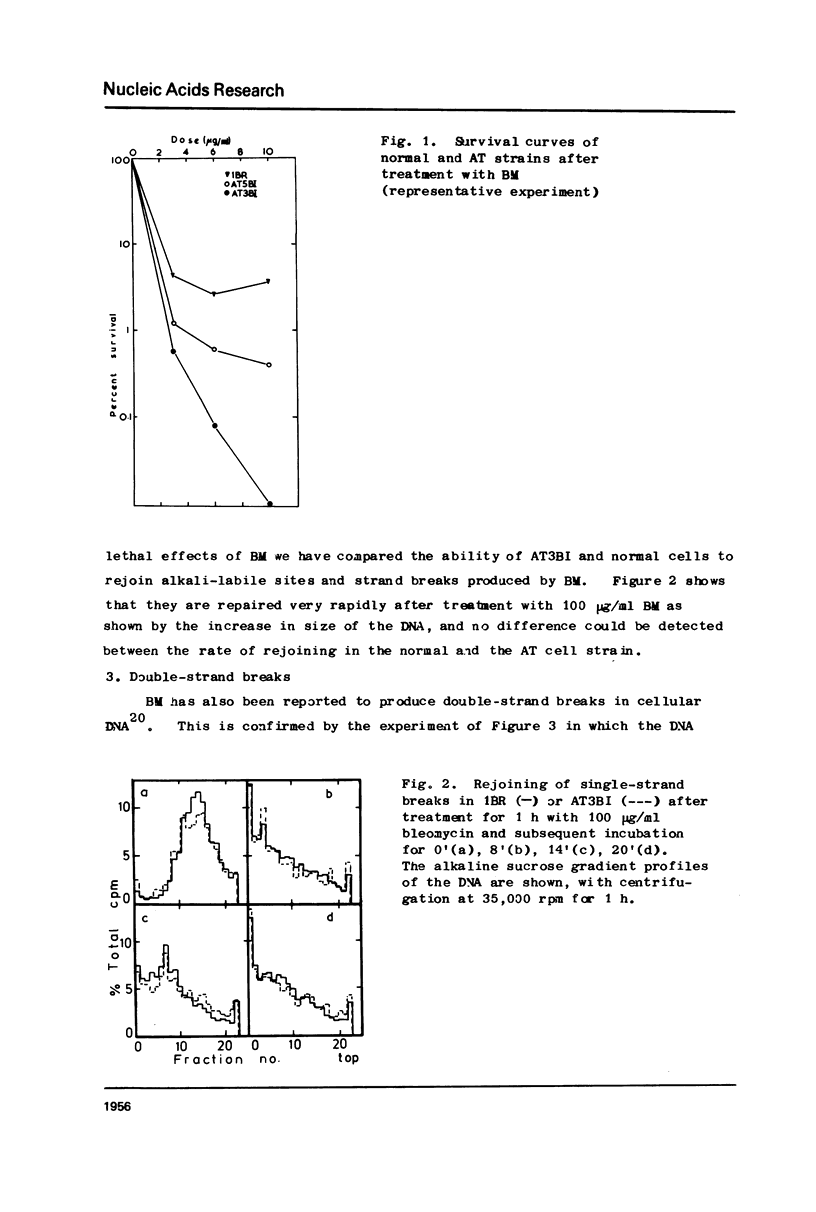
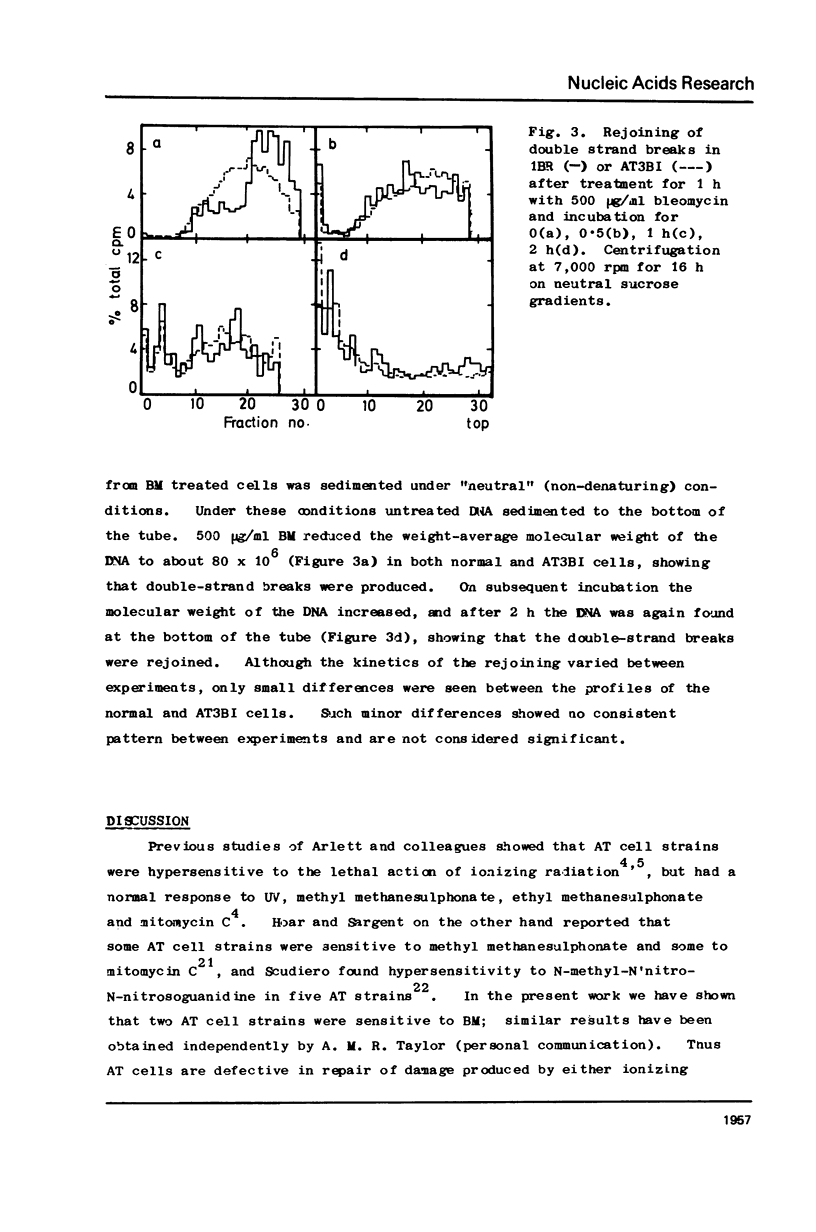
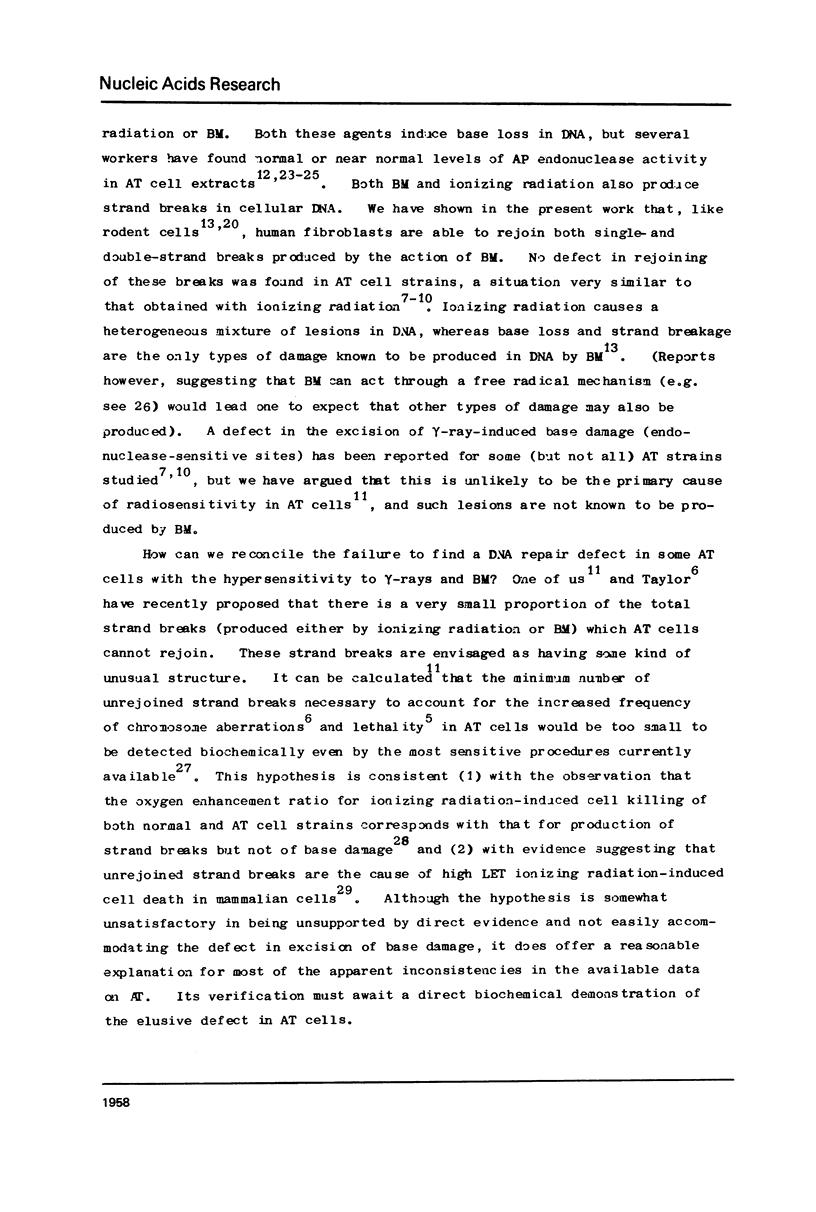
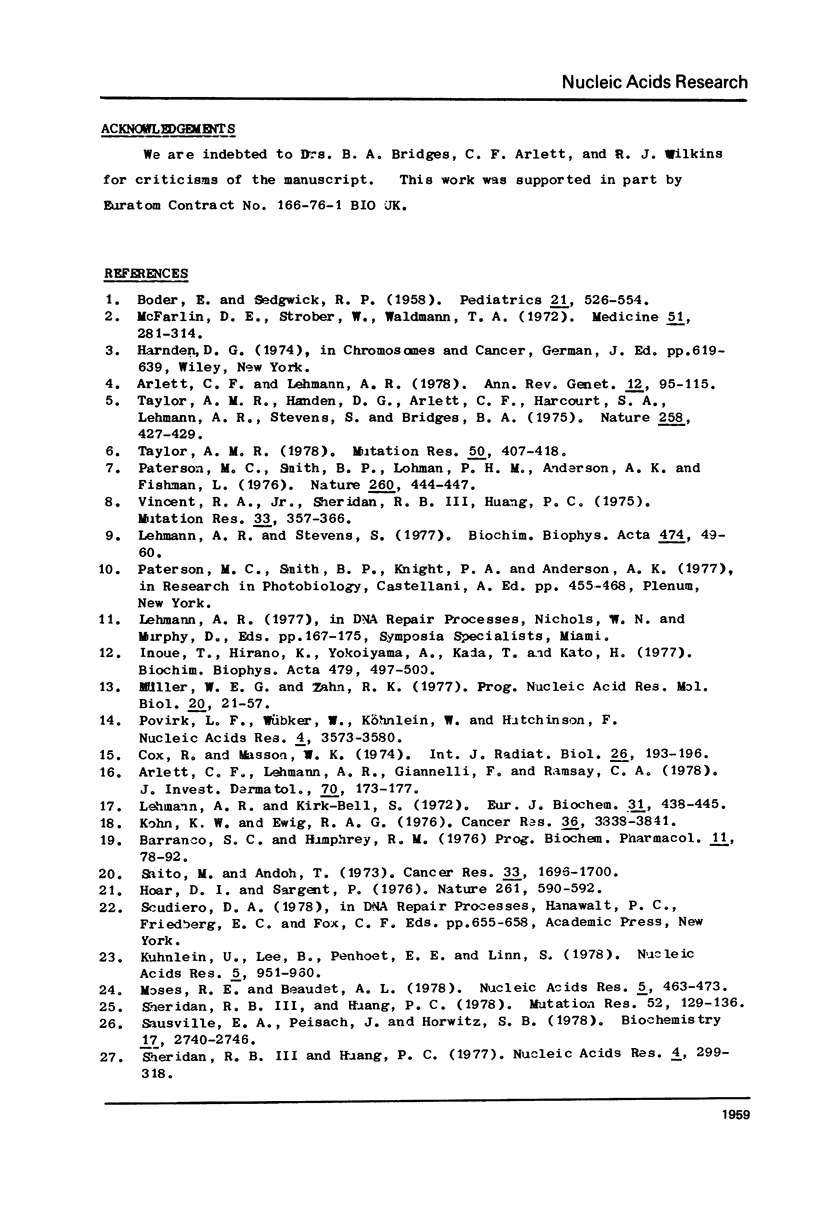
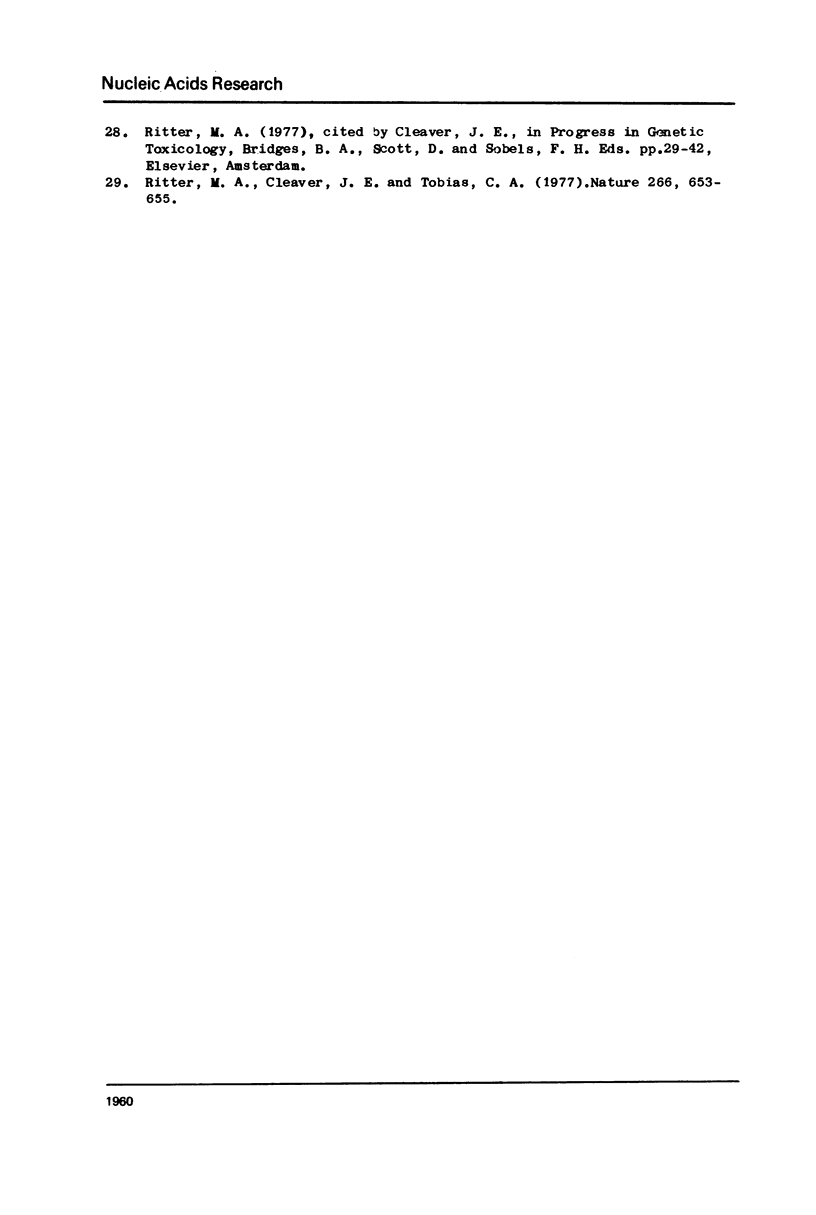
Selected References
These references are in PubMed. This may not be the complete list of references from this article.
- Arlett C. F., Lehmann A. R., Giannelli F., Ramsay C. A. A human subject with a new defect in repair of ultraviolet damage. J Invest Dermatol. 1978 Apr;70(4):173–177. doi: 10.1111/1523-1747.ep12541290. [DOI] [PubMed] [Google Scholar]
- Arlett C. F., Lehmann A. R. Human disorders showing increased sensitivity to the induction of genetic damage. Annu Rev Genet. 1978;12:95–115. doi: 10.1146/annurev.ge.12.120178.000523. [DOI] [PubMed] [Google Scholar]
- BODER E., SEDGWICK R. P. Ataxia-telangiectasia; a familial syndrome of progressive cerebellar ataxia, oculocutaneous telangiectasia and frequent pulmonary infection. Pediatrics. 1958 Apr;21(4):526–554. [PubMed] [Google Scholar]
- Barranco S. C., Humphrey R. M. Response of mammalian cells to bleomycin-induced potentially lethal and sublethal damage. Prog Biochem Pharmacol. 1976;11:78–92. [PubMed] [Google Scholar]
- Cox R., Masson W. K. Letter: Changes in radiosensitivity during the in vitro growth of diploid human fibroblasts. Int J Radiat Biol Relat Stud Phys Chem Med. 1974 Aug;26(2):193–196. doi: 10.1080/09553007414551141. [DOI] [PubMed] [Google Scholar]
- Hoar D. I., Sargent P. Chemical mutagen hypersensitivity in ataxia telangiectasia. Nature. 1976 Jun 17;261(5561):590–592. doi: 10.1038/261590a0. [DOI] [PubMed] [Google Scholar]
- Inoue T., Hirano K., Yokoiyama A., Kada T., Kato H. DNA repair enzymes in ataxia telangiectasia and Bloom's syndrome fibroblasts. Biochim Biophys Acta. 1977 Dec 14;479(4):497–500. doi: 10.1016/0005-2787(77)90042-9. [DOI] [PubMed] [Google Scholar]
- Kohn K. W., Ewig R. A. Effect of pH on the bleomycin-induced DNA single-strand scission in L1210 cells and the relation to cell survival. Cancer Res. 1976 Oct;36(10):3839–3841. [PubMed] [Google Scholar]
- Kuhnlein U., Lee B., Penhoet E. E., Linn S. Xeroderma pigmentosum fibroblasts of the D group lack an apurinic DNA endonuclease species with a low apparent Km. Nucleic Acids Res. 1978 Mar;5(3):951–960. doi: 10.1093/nar/5.3.951. [DOI] [PMC free article] [PubMed] [Google Scholar]
- Lehmann A. R. Post-replication repair of DNA in ultraviolet-irradiated mammalian cells. No gaps in DNA synthesized late after ultraviolet irradiation. Eur J Biochem. 1972 Dec 18;31(3):438–445. doi: 10.1111/j.1432-1033.1972.tb02550.x. [DOI] [PubMed] [Google Scholar]
- McFarlin D. E., Strober W., Waldmann T. A. Ataxia-telangiectasia. Medicine (Baltimore) 1972 Jul;51(4):281–314. doi: 10.1097/00005792-197207000-00002. [DOI] [PubMed] [Google Scholar]
- Moses R. E., Beaudet A. L. Apurinic DNA endonuclease activities in repair-deficient human cell lines. Nucleic Acids Res. 1978 Feb;5(2):463–473. doi: 10.1093/nar/5.2.463. [DOI] [PMC free article] [PubMed] [Google Scholar]
- Müller W. E., Zahn R. K. Bleomycin, an antibiotic that removes thymine from double-stranded DNA. Prog Nucleic Acid Res Mol Biol. 1977;20:21–57. doi: 10.1016/s0079-6603(08)60469-9. [DOI] [PubMed] [Google Scholar]
- Paterson M. C., Smith B. P., Lohman P. H., Anderson A. K., Fishman L. Defective excision repair of gamma-ray-damaged DNA in human (ataxia telangiectasia) fibroblasts. Nature. 1976 Apr 1;260(5550):444–447. doi: 10.1038/260444a0. [DOI] [PubMed] [Google Scholar]
- Ritter M. A., Cleaver J. E., Tobias C. A. High-LET radiations induce a large proportion of non-rejoining DNA breaks. Nature. 1977 Apr 14;266(5603):653–655. doi: 10.1038/266653a0. [DOI] [PubMed] [Google Scholar]
- Sausville E. A., Peisach J., Horwitz S. B. Effect of chelating agents and metal ions on the degradation of DNA by bleomycin. Biochemistry. 1978 Jul 11;17(14):2740–2746. doi: 10.1021/bi00607a007. [DOI] [PubMed] [Google Scholar]
- Sheridan R. B., 3rd, Huang P. C. Apurinic and/or apyrimidinic endonuclease activity in ataxia telangiectasia cell extracts. Mutat Res. 1978 Oct;52(1):129–136. doi: 10.1016/0027-5107(78)90101-x. [DOI] [PubMed] [Google Scholar]
- Sheridan R. B., 3rd, Huang P. C. Single strand breakage and repair in eukaryotic DNA as assayed by S1 nuclease. Nucleic Acids Res. 1977 Feb;4(2):299–318. doi: 10.1093/nar/4.2.299. [DOI] [PMC free article] [PubMed] [Google Scholar]
- Taylor A. M., Harnden D. G., Arlett C. F., Harcourt S. A., Lehmann A. R., Stevens S., Bridges B. A. Ataxia telangiectasia: a human mutation with abnormal radiation sensitivity. Nature. 1975 Dec 4;258(5534):427–429. doi: 10.1038/258427a0. [DOI] [PubMed] [Google Scholar]
- Taylor A. M. Unrepaired DNA strand breaks in irradiated ataxia telangiectasia lymphocytes suggested from cytogenetic observations. Mutat Res. 1978 Jun;50(3):407–418. doi: 10.1016/0027-5107(78)90045-3. [DOI] [PubMed] [Google Scholar]
- Vincent R. A., Jr, Sheridan R. B., 3rd, Huang P. C. DNA strained breakage repair in ataxia telangiectasia fibroblast-like cells. Mutat Res. 1975 Dec;33(2-3):357–366. doi: 10.1016/0027-5107(75)90211-0. [DOI] [PubMed] [Google Scholar]


